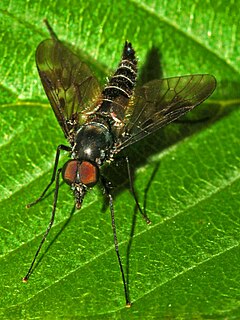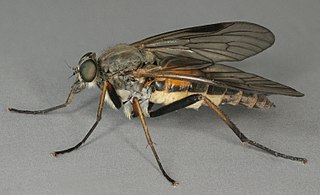
The black-tailed skimmer is a dragonfly belonging to the family Libellulidae.

The Brachyceran family Vermileonidae is a small family of uncertain affinities and unusual biology. It includes fewer than 80 described species, most of them rare and with restricted distribution, in 10 genera. Historically the vermileonids had been regarded as belonging to the family Rhagionidae, possibly in a subfamily Vermileoninae. Their biology and morphology is so markedly distinct from the main Rhagionidae sensu stricto however, that the placement as a separate family has been widely accepted.

The Agromyzidae are a family commonly referred to as the leaf-miner flies, for the feeding habits of their larvae, most of which are leaf miners on various plants.

The lesser house fly or little house fly, Fannia canicularis, is somewhat smaller than the common housefly. It is best known for its habit of entering buildings and flying in jagged patterns in the middle of a room. It is slender, and the median vein in the wing is straight. Larvae feed on all manner of decaying organic matter, including carrion.

Rhagionidae or snipe flies are a small family of flies. They got their name from the similarity of their, often, prominent proboscis that looks like the beak of a snipe.

Athericidae is a small family of flies known as water snipe flies or ibis flies. They used to be placed in the family Rhagionidae, but were removed by Stuckenberg in 1973. They are now known to be more closely related to Tabanidae. Species of Athericidae are found worldwide.

Minucia lunaris, the lunar double-stripe or brown underwing, is a species of moth in the family Erebidae. The species was first described by Michael Denis and Ignaz Schiffermüller in 1775 and is found in Asia, Europe and North Africa.

Mythimna separata, the northern armyworm, oriental armyworm or rice ear-cutting caterpillar, is a moth of the family Noctuidae. It is found in China, Japan, South-east Asia, India, eastern Australia, New Zealand, and some Pacific islands. It is one of the major pests of maize in Asia. The species was first described by Francis Walker in 1865.

Fannia scalaris, also known as the latrine fly, is a fly species in the Fanniidae family. This species is smaller and more slender than the house fly, Musca domestica, and is similar in appearance to the lesser house fly, Fannia canicularis. The life cycle of this species can be as long as one month. These flies are globally distributed in urban areas as they are drawn to unsanitary environments. F. scalaris is a major cause of myiasis, the infestation of a body cavity by fly maggots. The adults infest bodies that have decomposed, making the species an important part of forensic entomology. The larvae of this fly have adapted protuberances, or feathered appendages, that allow them to survive in such a moist environment. Entomologists continue to research the effects that F. scalaris may have medically, forensically, and on the environment around them.

Tachina fera is a species of fly in the genus Tachina of the family Tachinidae. It was first described by Carl Linnaeus in 1761.

The desert whitetail is a species of dragonfly in the family Libellulidae. P. subornata is often put into the genus Libellula.

Ambulyx moorei, the cinnamon gliding hawkmoth, is a moth of the family Sphingidae. The species was first described by Frederic Moore in 1858. It is found in Sri Lanka, southern and eastern India, the Nicobar Islands and Andaman Islands, Thailand, Vietnam, southern China, the Philippines, Malaysia, Singapore and Indonesia.

Rhagio scolopaceus is a species of fly from the family Rhagionidae. It is also known as the downlooker snipefly. It is the type species of the genus Rhagio.

Oplodontha viridula, the common green colonel, is a European species of soldier fly.
Parcoblatta notha, the Arizona wood cockroach, is a species of wood cockroach that occurs only in the southwestern US state of Arizona. It is a relatively large, light colored member of the 12-species wood cockroach genus Parcoblatta. The male has fully developed wings and is able to fly, while the female wings are around half as long and does not fly.

Rhagio tringarius, common name marsh snipefly, is a species of fly from the family Rhagionidae.

Rhagio lineola is a species of 'snipe flies' belonging to the family Rhagionidae. It is a Palearctic species with a limited distribution in Europe.

Rhagio punctipennis, the lesser variegated snipe fly, is a species of snipe flies in the family Rhagionidae.

Rhagio annulatus is a Palearctic species of snipe fly in the family Rhagionidae.

Rhagio notatus is a Palearctic species of snipe fly in the family Rhagionidae.


















